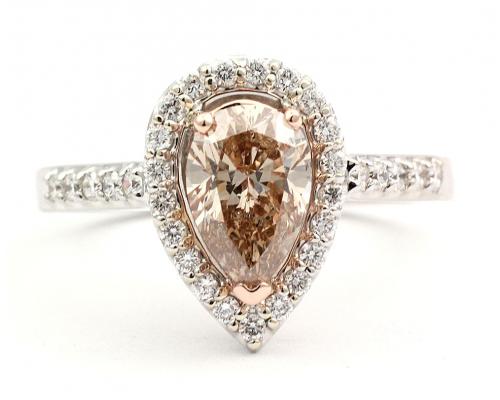Understanding Colour Characteristics
In the diamond grading system, hue refers to the specific colour or shade that a diamond displays, affecting its overall appearance and value. While diamonds are typically graded based on colourless to near-colourless or fancy coloured categories, certain diamonds, especially those in the Cape Series or with a colourless designation, may have a slight tint that impacts their perceived hue.
The Role of Hue in Diamond Grading
Hue is an important factor in the colour grading of diamonds, particularly in diamonds that are not completely colourless. In the grading system, hue describes the presence and intensity of coloured tints like brown, grey, or even brownish-yellow that might be visible in a diamond. While hue is not always as prominent in diamonds graded as colourless, those with a hue are generally considered less valuable.
1. Cape Series Diamonds:
Cape Series diamonds, which typically show a pale yellow or brownish tint, are graded based on their colour saturation. These diamonds can sometimes exhibit hues of brown or grey, which are classified as negative tints. While the diamond might still fall within a certain colour grade (e.g., G, H, I), the presence of a visible hue can lower its desirability and market value compared to diamonds with no noticeable hue.
2. Diamonds with Visible Hues:
When diamonds exhibit visible hues, such as a brownish or greyish tint, the colour grading certificate will specify this on the report. These hues affect the diamond’s overall colour impression and often reduce its value compared to a colourless or near-colourless diamond. The presence of such hues can be classified into categories like brown, grey, or ECG (Earth Colored) hues, each indicating a lower quality than a diamond with a neutral or non-existent hue.
The Impact of Hue on Diamond Value
Diamonds with hues such as brown or grey typically fall into a lower value category compared to diamonds without such tints. This is because these hues can detract from the diamond’s brilliance and fire, which are the qualities that make diamonds especially attractive.
1. Brown Hue:
Brown diamonds, often called “chocolate” diamonds, have a distinct, warm tint that can affect the overall appearance. When the brown hue is prominent, the diamond may appear less clear and vibrant. Brown-tinted diamonds are usually graded as lower value diamonds, although some brown diamonds with desirable colours can still have significant value (e.g., fancy brown diamonds).
2. Grey Hue:
Grey diamonds, which display a greyish tint, may appear muted or dull, reducing their visual appeal. This greyish colour is less desirable in diamonds compared to colourless or fancy-coloured diamonds, leading to a decrease in market value.
3. ECG Hue (Earth-Colored):
ECG diamonds, characterised by natural earthy colours like brown, green, or grey, are typically less valuable than those with clear, vibrant colours. These hues, while still natural, can reduce a diamond’s desirability in the market, especially if they are overly pronounced.
Where to Find Hue on a Diamond Certificate
The presence of a hue in a diamond will often be indicated on its grading report or diamond certificate. On reports issued by reputable gemological laboratories like the GIA, IGI, or DCLA, hue will be listed along with other characteristics such as colour grade, clarity, and cut.
On a GIA Diamond Grading Report, for example, the hue will be detailed alongside the colour grade (e.g., D, E, F for colourless diamonds). Any visible hue, like brown or grey, will be noted separately on the report to give a clear understanding of the diamond’s overall appearance.
The grading report also notes how hue affects the diamond’s overall visual impression. If there is no noticeable hue (or if the hue is very faint), the diamond will be graded as colourless or near-colourless, and this will be reflected on the certificate.
Understanding the Significance of Hue in Diamond Purchasing
1. Buyer Preferences:
For many buyers, the presence of a hue can be a deciding factor. If you are seeking a high-quality diamond with exceptional brilliance, diamonds with no visible hue are generally preferred. However, some buyers appreciate the natural character of diamonds with a slight brown or grey hue, especially when purchasing brown diamonds or fancy-coloured diamonds.
2. Investment Considerations:
In terms of investment, diamonds with noticeable hues are usually less valuable than those that are colourless or near-colourless. However, some brown or fancy coloured diamonds with the right hue can still be considered valuable due to their rarity or unique appearance.
Conclusion: The Importance of Hue in Diamond Grading
Hue plays a crucial role in the grading and valuation of diamonds. Diamonds with visible brown, grey, or ECG hues generally have a lower value compared to diamonds with no noticeable tint. When buying a diamond, it’s essential to consider the hue as part of the overall assessment of the diamond’s colour and quality. Whether you are purchasing for personal use or as an investment, understanding how hue influences a diamond’s appearance and value is vital for making an informed decision.
